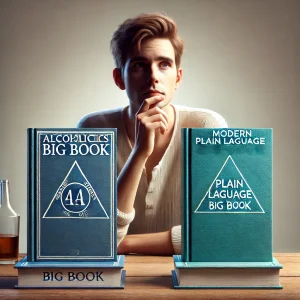 The upcoming release of the Plain Language Big Book, a new edition of the foundational text of Alcoholics Anonymous (AA), has sparked conversation and controversy within the recovery community. Designed to make the original Big Book more accessible to modern readers, this project aims to retain the core principles of AA while simplifying its language and updating its tone for contemporary audiences. Yet, for many, the idea of altering even a single word of the original text feels like sacrilege. After all, this book has been instrumental in saving millions of lives since its first publication in 1939.
The upcoming release of the Plain Language Big Book, a new edition of the foundational text of Alcoholics Anonymous (AA), has sparked conversation and controversy within the recovery community. Designed to make the original Big Book more accessible to modern readers, this project aims to retain the core principles of AA while simplifying its language and updating its tone for contemporary audiences. Yet, for many, the idea of altering even a single word of the original text feels like sacrilege. After all, this book has been instrumental in saving millions of lives since its first publication in 1939.
This effort to reimagine a classic reflects a broader tension within AA and other recovery traditions: how to balance reverence for the past with the need to evolve for the future. The challenge of creating a plain language edition goes far beyond paraphrasing. It requires honoring the heart of a sacred text while recognizing that the language and cultural assumptions of the 1930s may alienate some of today’s readers. At its core, this project raises an important question: when does protecting tradition hinder the opportunity to reach those who still suffer?
The Challenge of Changing a Sacred Text
The Big Book is often seen as more than just a guide—it’s a lifeline, a spiritual blueprint, and, for some, a sacred scripture. Its words have offered hope and transformation to countless individuals. For those who owe their sobriety to its teachings, any changes, no matter how small, may feel like tampering with something divine.
Yet, as the decades have passed, the original text has grown increasingly challenging for some readers. Its language reflects a time when society was very different, and its references can seem distant or exclusionary to modern audiences. The plain language edition seeks to bridge this gap, offering the same life-saving message in a way that feels relevant and accessible to all.
Still, the resistance to change highlights a broader truth about AA: dogmatic truths that once saved us can become obstacles to progress. In the case of the Big Book, the tension lies in how to maintain the integrity of the message while ensuring it remains inclusive and effective in a rapidly changing world.
When Dogmatic Truths Become Resistant to Change
The very elements that make the Big Book powerful—its foundational truths about surrender, community, and spirituality—also make it resistant to revision. Dogma, while grounding, often stems from fear: fear of losing what works, fear of diluting the message, fear of failing those who still suffer.
But history shows us that truths must sometimes evolve to remain effective. Consider the gradual inclusion of women, LGBTQ+ individuals, and people of color in AA. These changes were not easily won. They were met with resistance but ultimately made the program stronger and more inclusive. Similarly, the plain language Big Book is an acknowledgment that accessibility matters—that the life-saving principles of recovery should never be locked behind barriers of language or cultural disconnect.
This tension isn’t unique to AA. Across all systems and traditions, deeply held beliefs often clash with the need for progress. Nowhere is this more evident than in the reemergence of psychedelics as a potential tool for recovery.
Psychedelics: Evolution, Not Replacement
The emergence of psychedelics as a tool for recovery represents one of the most significant developments in addiction treatment today. Contrary to fears within traditional recovery communities, psychedelics are not here to replace AA but to enhance it. Their role isn’t to challenge the 12 steps but to provide deeper insights into the trauma, disconnection, and spiritual challenges that underlie addiction.
This is not an entirely new concept. Bill Wilson, AA’s co-founder, explored the use of LSD in the 1950s as a way to facilitate spiritual awakenings and help those struggling with faith. Wilson believed that psychedelics could help individuals connect with the Higher Power so central to the recovery process. While his ideas were sidelined due to stigma and fear, modern research has reignited interest in how substances like psilocybin and MDMA might complement traditional recovery approaches.
For some, psychedelics serve as a bridge, breaking through barriers that might otherwise prevent individuals from fully engaging with the steps. In this sense, they align with the spirit of AA: helping the suffering find a path to healing, whatever that path may look like.
The Slow Evolution of AA
The history of AA is one of slow but meaningful change. Its decentralized structure empowers local groups to remain autonomous, but it also makes large-scale innovation difficult. This ensures the program’s core remains intact, but it can also mean progress is hard-won.
The plain language Big Book and the growing conversation around psychedelics in recovery both reflect this pattern of cautious evolution. Each step forward is met with debate, and rightly so. Yet, both changes underscore a vital truth: growth doesn’t come from abandoning tradition but from adapting it to meet the needs of today.
Honoring the Past, Embracing the Future
The release of the plain language Big Book is a milestone in AA’s history, a reminder that even the most revered texts must evolve to remain effective. It reflects an acknowledgment that accessibility matters, that language and context can either welcome or alienate, and that the heart of recovery lies not in rigid adherence to tradition but in the ability to reach those who still suffer.
Similarly, the inclusion of psychedelics in recovery represents a growing willingness to explore new tools in the fight against addiction. Together, these shifts point to a brighter future for recovery—one in which the wisdom of the past and the innovations of the present work together to save lives.
Ultimately, both the plain language Big Book and the broader acceptance of psychedelics in recovery remind us of a crucial truth: the principles of healing are timeless, but the methods must evolve. In the pursuit of sobriety, it’s not tradition that matters most but the ability to bring hope to those still struggling.




